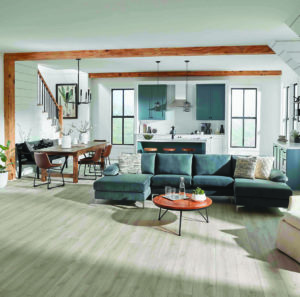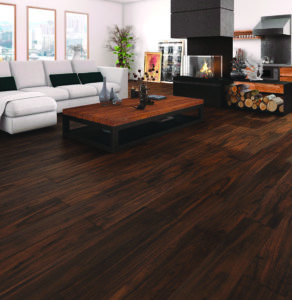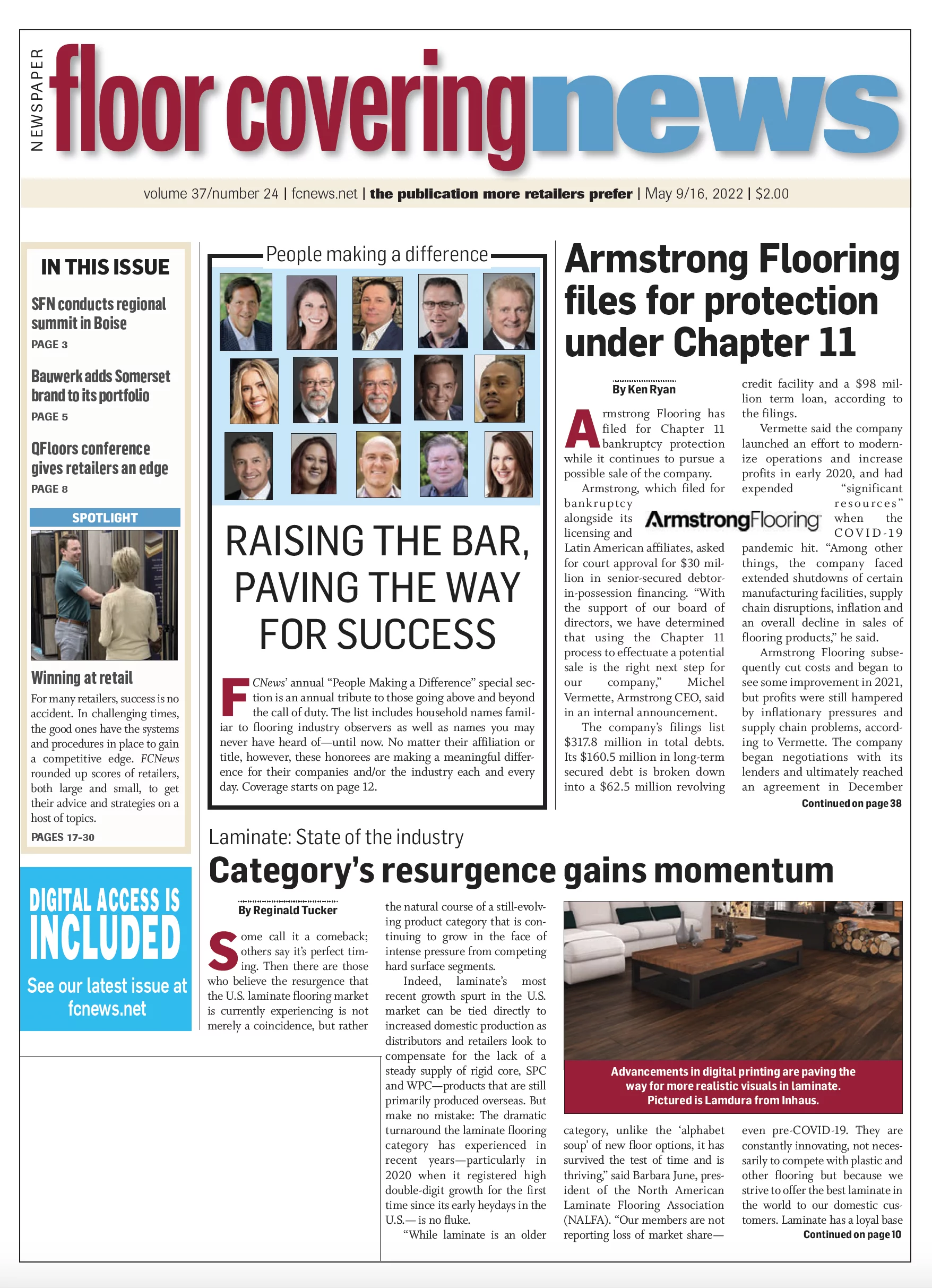Some call it a comeback; others say it’s perfect timing. Then there are those who believe the resurgence that the U.S. laminate flooring market is currently experiencing is not merely a coincidence, but rather the natural course of a still-evolving product category that is continuing to grow in the face of intense pressure from competing hard surface segments.
Indeed, laminate’s most recent growth spurt in the U.S. market can be tied directly to increased domestic production as distributors and retailers look to compensate for the lack of a steady supply of rigid core, SPC and WPC—products that are still primarily produced overseas. But make no mistake: The dramatic turnaround the laminate flooring category has experienced in recent years—particularly in 2020 when it registered high double-digit growth for the first time since its early heydays in the U.S.— is no fluke.

“While laminate is an older category, unlike the ‘alphabet soup’ of new floor options, it has survived the test of time and is thriving,” said Barbara June, president of the North American Laminate Flooring Association (NALFA). “Our members are not reporting loss of market share—even pre-COVID-19. They are constantly innovating, not necessarily to compete with plastic and other flooring but because we strive to offer the best laminate flooring in the world to our domestic customers. Laminate has a loyal base of end users that recognizes the beauty, durability and sustainability of laminate floors.”
NALFA manufacturer members like Swiss Krono USA, a private-label supplier whose diverse customer base includes retailers, distributors and some of the biggest names in flooring, attest to the product’s growth and viability. “Domestic laminate flooring has certainly enjoyed a surge during the COVID-19 period and resulting global supply chain restraints both from availability and the dramatic transport cost increases we have seen from Asia and Europe,” explained Kyle Brown, executive vice president of sales and marketing. “We believe laminate will maintain its posture in the marketplace.”
Any loss of laminate’s share to competing categories, according to Brown, has been minimal—if at all. “Most of the impact of the popularity of plastic products has come at the expense of carpet,” he noted. “Laminate is a mature product that has responded to the plastic threat by organic improvement to protect share. These improvements include better quality decors, more intricate textures and a rapid evolution of moisture-resistant/waterproof laminate offerings.”
Some suppliers are hesitant to describe laminate’s performance as a resurgence. “From our point of view, laminate never left,” said David Sheehan, vice president, residential hard surface, Mannington, which continues to report double-digit sales increases in the category. “Having said that, over the past year or so we have seen a renewed interest in the category for a variety of reasons: easy-to-install mechanical locking systems; embossed-in-register design for an extremely realistic texture; digital printing for crisp and clear visuals; extraordinary scratch and dent resistance and waterproof technologies.”
Seth Arnold, vice president, residential marketing, Mohawk, concurred. “Without a doubt, laminated wood has never left. Our formula is a waterproof wood with exceptional durability that is easy to clean, at a price she can afford and retailers can turn a profit.”
That has long been the winning proposition at Inhaus, whose support of the category has never wavered. “Laminate is one of the flooring categories with the lowest cost, complemented with leading scratch and wear resistance,” said Derek Welbourn, the company’s CEO. “The combination of leading design, wear performance and cost is a value proposition for laminate that is very powerful.”
Amy Watkins, business manager, Create Flooring, agreed. “The company is seeing success with its Lofts collection, and I believe much of that can be attributed to the fact that Lofts provides scratch resistance that SPC does not. So, combined with the water resistance, there is a performance story.” That leads to a price/value relationship that puts laminate “right there” with SPC, she said.
Factors impacting growth
The surge the category has experienced in recent years is not without its challenges, however. Along with strong interest among consumers as well as jockeying among suppliers comes competitive pressures that stand to impact the segment in a significant way.
“There are definitely increasing pricing pressures from new players entering the market (Europe and Asia) causing an increase in competition,” said Bill Ko, CEO of Johnson Hardwood, which recently added laminate to its growing hard surface portfolio. “The pandemic has caused a lot of supply issues, whether it be from long lead times, increased raw material costs or flat-out insufficient production capacity. This, in turn, has brought more opportunity for laminate products. Because of this, domestic laminate production will not likely be able to meet the increasing demand. This has caused some dependency on imported laminate products from Europe and China.”
These factors are also driving up the selling price on imported laminate. “Ocean freight is still high, so Europe will have higher costs than U.S.-made laminate, and products made in China will have an even higher cost due to ongoing tariffs,” Ko added. “On the other hand, with limited availability of wood flooring products, this does invite opportunity to sell laminate even at the higher costs because there is inventory.”
Other industry observers attest to the impact of these factors. As Swiss Krono’s Brown put it, “The main challenge entails staying ahead of rapidly rising raw material and manufacturing costs, measuring the consumer’s response to the corresponding retail price increases and managing the product mix to provide needed domestic capacity, as possible to our U.S. customers.”
It’s a sentiment echoed by other major laminate flooring suppliers. “While supply chain constraints are likely to remain to a similar degree, we will continue to innovate and find ways to add value to ensure our growth within the category,” said Barron Frith, president of CFL North America. “We are preparing for a similar year full of challenges but also opportunities particularly in the value-added section.”
By and large, laminate suppliers—especially NALFA members—say they are well positioned to deal with any headwinds. “We have all felt extreme pressure from raw material costs, allocation of material and customer demand,” June explained. “The bright side is that our NALFA manufacturing members are nimble and have shown the ability to adjust more quickly to our respective customer needs, from creating new and innovative products to offering a wider mix, all the while maintaining high perceived product value.”
Ongoing innovation
In much the same way that laminate broke new ground in key areas such as durability and aesthetic appeal when the category first came on the scene in the U.S. market in the mid-’90s, the segment is looking to usher in ongoing innovations as it seeks to continue to grow share. These include improvements in water resistance as well as other performance enhancements that aim to raise the ante on dent and scratch resistance.
CFL’s Frith agreed. “Added value/innovation will be key for 2022 to ensure continuous growth for us in the category. A good example for this are our 86-inch laminate planks with AC5 heavy commercial wear rating. Also, the fact that waterproof laminates are PVC free is playing a more important role to eco-conscious consumers.”

Beyond product performance, suppliers are also making strides in the realm of digital printing. Case in point is Mannington’s Restoration collection, which has been further enhanced to offer the consumer fewer pattern repeats in a single installation—a criticism of laminate floors of yesteryear. “We continue to leverage our digital print technology with successful new introductions that deliver meaningful differentiation to the consumer and retailer,” Sheehan said.
In that same vein, Mohawk raised the stakes in laminate flooring visuals with the recent debut of its Signature technology. The innovation is based on a process that captures natural designs by scanning, cataloging and preserving the extraordinary detail and variety common to each wood species. The microdata is then transferred to a flooring plank.
“We transfer 64 layers of information onto exclusive, specially crafted Signature plates that create a multidimensional beauty you can see and feel,” said David Moore, senior product director, wood and laminate. “Then Signature’s clarity finish achieves four-times more resolution than previous methods and contains up to 1,000 unique colors in every square inch. The result is flooring that is indistinguishable from the original, both in look and feel.”
Eternity, another major supplier, is banking heavily on laminate’s revival. And it’s investing heavily in new technology and manufacturing processes to demonstrate that commitment. “The revolutionary waterproof technology is just the beginning of many innovations to come,” said Isaac Lee, product development. As an example, he cited the company’s new AquaFi Waterproof Laminate Flooring. Made In the USA, Eternity AquaFi is GreenGuard Gold Certified with zero added formaldehyde and comes with acoustical pad pre-attached. The company also launched the Ecoessent Premium Aqua-Resilience brand of waterproof, environmentally friendly composite laminate floors.
Not to be outdone, CFL—via its popular AtroGuard line—is also leveraging sophisticated digital printing technologies to render more realistic visuals. “One of the biggest advantages for AtroGuard is the amount of unique visuals, making it very realistic and very hard to see repeats once the floor is installed,” Frith explained. “That is technically more difficult to achieve with vinyl floors, although they are rapidly catching up.”
Medium-term outlook
With all that laminate flooring has going in its favor, it’s hard to be anything but upbeat about the category’s prospects in the short to medium term. “Laminate has by far the most responsible/sustainable environmental story of floor covering choices, and this is gaining traction with the emerging millennial home owners,” Swiss Krono’s Brown said.
For Mannington, new growth is expected to come from a resurgence at specialty retail combined with strong builder growth. “Home centers continue to be major players as well,” Sheehan noted, adding, however, that some laminate real estate in that channel has been converted to LVT.
Inhaus’ Welbourn predicted the repair and remodeling segment will represent the majority of growth for the category, although he said he’s also seeing interest in the building sector across both single-family and multi-family applications. “Laminate has seen significant growth in 2021, and we see this continuing for 2022.”
Of course, so much depends on how things shake out with the current supply chain challenges. “If our supply chains stabilize and we are able to get to a more affordable pricing structure, this category definitely has a chance to last longer than we think. With wood and SPC products not being as scratch resistant, water-resistant laminate has a really good chance to regain market share because of the newer technologies that allow higher-end laminate not only to look and feel like real wood, but also to perform better.”
These attributes, suppliers say, will only expand the category’s appeal beyond traditional residential replacement applications. “We see tremendous opportunities in both specialty retail and our builder/multi-family segments,” Mohawk’s Moore noted.

